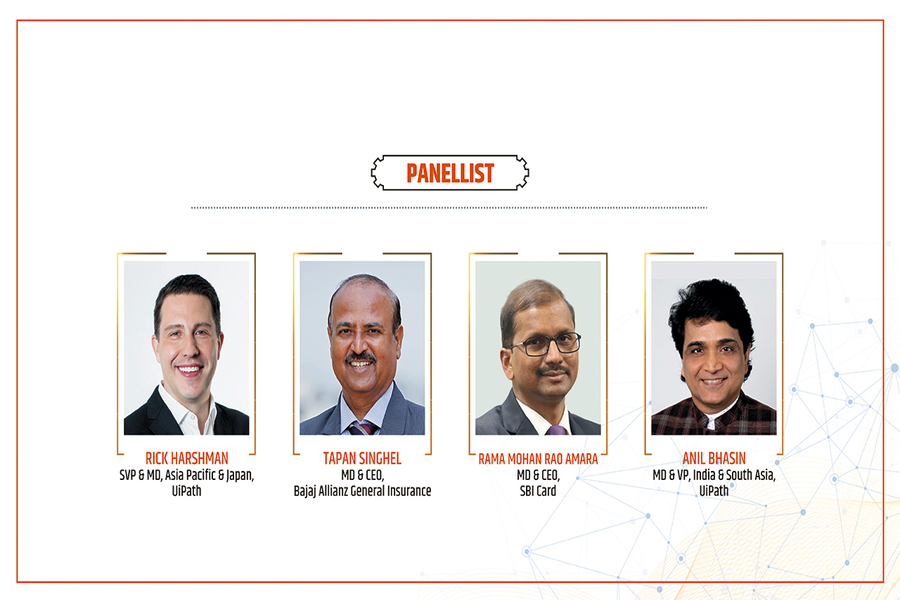Demonstrating ownership and commitment to making a change in an era of digital transformation

As the pandemic accelerates the transition to a virtual engagement between employees, suppliers, vendors and consumers, managing this change to create an organic ecosystem where everyone wins, is what will separate leaders from managers.
To profile such lessons in excellence, Forbes India Influencers of Change, in partnership with UiPath, hosted a panel of leaders who shared their experience and insights on innovating the right way for the future. These thought leaders comprised Tapan Singhel, MD & CEO, Bajaj Allianz General Insurance; Rama Mohan Rao Amara, MD & CEO, SBI Card; Rick Harshman, SVP & MD, Asia Pacific & Japan, UiPath and Anil Bhasin, MD & VP, India & South Asia, UiPath.
Moderated by Gautam Srinivasan, the discussion flowed seamlessly from influencers to instruments and finally, to inspirations. It began by exploring how leaders could demonstrate ownership and commitment to change, as any transformation passes through the phases of discovery, building, management and implementation.
Tapan Singhel opined, “Leaders should not be swayed by fancy words and jargon being thrown around. They must be clear about the purpose of the transformation and what they expect it to lead to. Then they must discuss it with the C-suite and form a common vision. Once this is done, the transformation gets into a hyper space and moves very fast as people are excited to make a difference to consumers or society or the country or world, at large.”
Adding on another prerequisite for sterling leadership, Rama Mohan Rao Amara suggested that a leader must rise above the pressure to look at immediate quarters. “One needs to look at the ecosystems that exist and may be disrupting business models in a very subtle way, which is not palpable from quarter to quarter,” he said. “Leaders who have insights into such changes should discuss them with the senior management and together they must modify the core of their strategy to accommodate and leverage these changes and disruptions.”
Rick Harshman shared that one of the axioms of the UiPath team was ‘Change is the oxygen that we breathe’. “Change is going to happen,” he asserted. “It is up to us, as leaders, to help our teams through this change, internally or externally. We must articulate the vision, the mission and then the execution behind that change.” More broadly, he pointed out that it was the responsibility of leaders to see ahead of the curve and provide guidance to their teams. Since the pace of change has accelerated, the need to simplify the complexity around the teams is more important than ever before. He also suggested that the board and C-suite must demonstrate the conviction along with the commitment to see strategic transformation through.
Moving on to how digital solutions have helped manage risks and business continuity and enabled enterprises to build greater resilience from a strategic perspective, Anil Bhasin said, “No one envisaged the pandemic and yet we’ve morphed from a very physical world to a very digital world. It has taught us the criticality of maintaining business continuity of operations with manual handoffs. Even traditional businesses have catalysed their tech adoption.” He submitted that Covid19 had acted as a great catalyst, making digital transformation a boardroom priority. Once this priority is set, he assured that UiPath was keen to help corporates on their digital transformation journeys.
Agreeing, Rama Mohan Rao Amara added, “The pandemic has forced the change. When employees could not come to the office we were forced to prasovide them with laptops, connectivity, VPN, etc, which took some time but we learned quick. We were much better prepared during the second wave.”
When the discussion shifted gears to the instruments of change, the panel unanimously agreed that digital was the primary enabler during the black swan event of the Covid19 pandemic. Tapan Singhel elaborated on how insurance used to be a conversational sale and direct-to-customer has not seen any large measure of success before the pandemic. “When Covid19 struck, everyone from regulators to companies enabled automation and customers and distributors adopted it at a hyper speed,” he said. Being ahead on the automation curve, the transition was smooth for his company. “We issued 20 million policies and settled 3-4 million claims without physical documents and papers. The grievance ratio dropped by 90%. It was an interesting experience for me,” he said.
Anil Bhasin concurred, narrating that there were numerous automation success stories that his insurance company clients had witnessed across the spectrum from claims settlement to fraud detection, assessment, policy administration, servicing, customer experiences, renewal reminders, sales distribution, reporting and audit. They noted gains from backend automation in the form of lower operational costs, better productivity and greater efficiency. “Improved customer experience is a new conversation,” he ventured, adding, “Automation has moved from being a tactically necessary technology layer to a business outcome driven requirement.”
Digitization poses new and meaningful disruptions to organisational change. It gives rise to various challenges that leaders must address, with respect to the scope and scale of transformation, finding talent with new skillsets and new approaches to assessment. Further, with the speed at which tech advancement taking place, leaders who are able to foresee and implement change before it becomes crucial are the ones who drive great benefits. “A leader must be passionate about the industry they work in and must be constantly thinking about how to redefine and change it and work towards taking it to a higher level,” said Tapan Singhel.
The planel discussed how running a business has become more complex by many multiples, due to shorter cycles of change, the impact of geo-political developments, sustainability factors, increasing levels of regulation, leading to multiple levels of processes, internally and externally, within businesses. They observed that marrying intelligent automation and AI could influence change for enterprises and free up bandwith for leaders in the face of these complexities. Automation, which helps manage these processes more efficiently and effectively, improves productivity and allows CEOs and the C-suite to spend their time where it really matters – with customers , partners and employees.
The webinar concluded with the participants sharing their visions about the future of automation and how it could be made more accessible and inclusive. Tapan Singhel believed that empowering the front-end of businesses to automate and stay excited about it would be the next frontier. Innovation, according to him, is not the prerogative of specific teams or leaders; it should be a mission for everyone at the front-end. “The more the frontend is empowered, the more excited they are and the more aligned they will be to the vision of transforming the industry and getting customer experience to the next level,” he said.
Rama Mohan Rao Amara reckoned that within an organisation, the capabilities of human resources must be augmented, people must be trained and helped to upskill, to enhance the convenience of the consumer. “The possibilities are limitless and values are immense,” he said.
Speaking as an automation industry expert, Anil Bhasin’s message to leaders was, “Our mantra is to leverage technology to service the needs of every Indian and multi-national organisation, efficiently and effectively. I also believe we have the talent and willingness and the use-cases that will enable us to create an impact, not just for our organisations but for the world.”
Rick Harshman summed up, reminding the forum about the bottomline in a business, saying, “As intelligent automation takes over the work load of processes, it frees up time for every constituent of businesses to listen to their customer with empathy, solve their problems and deliver an exceptional experience.”
The pages slugged ‘Brand Connect’ are equivalent to advertisements and are not written and produced by Forbes India journalists.



